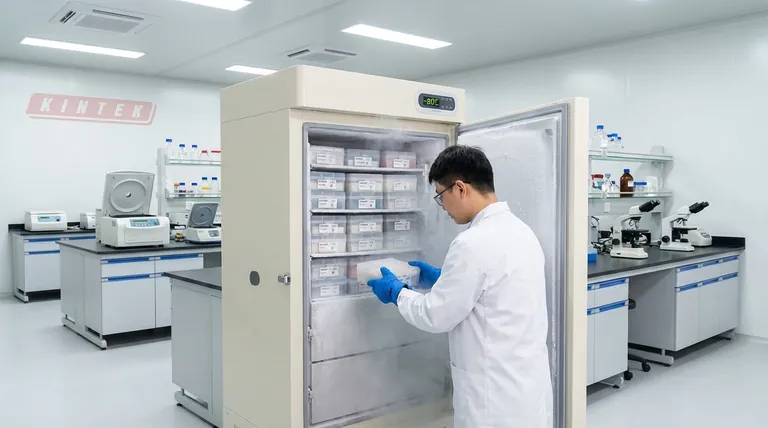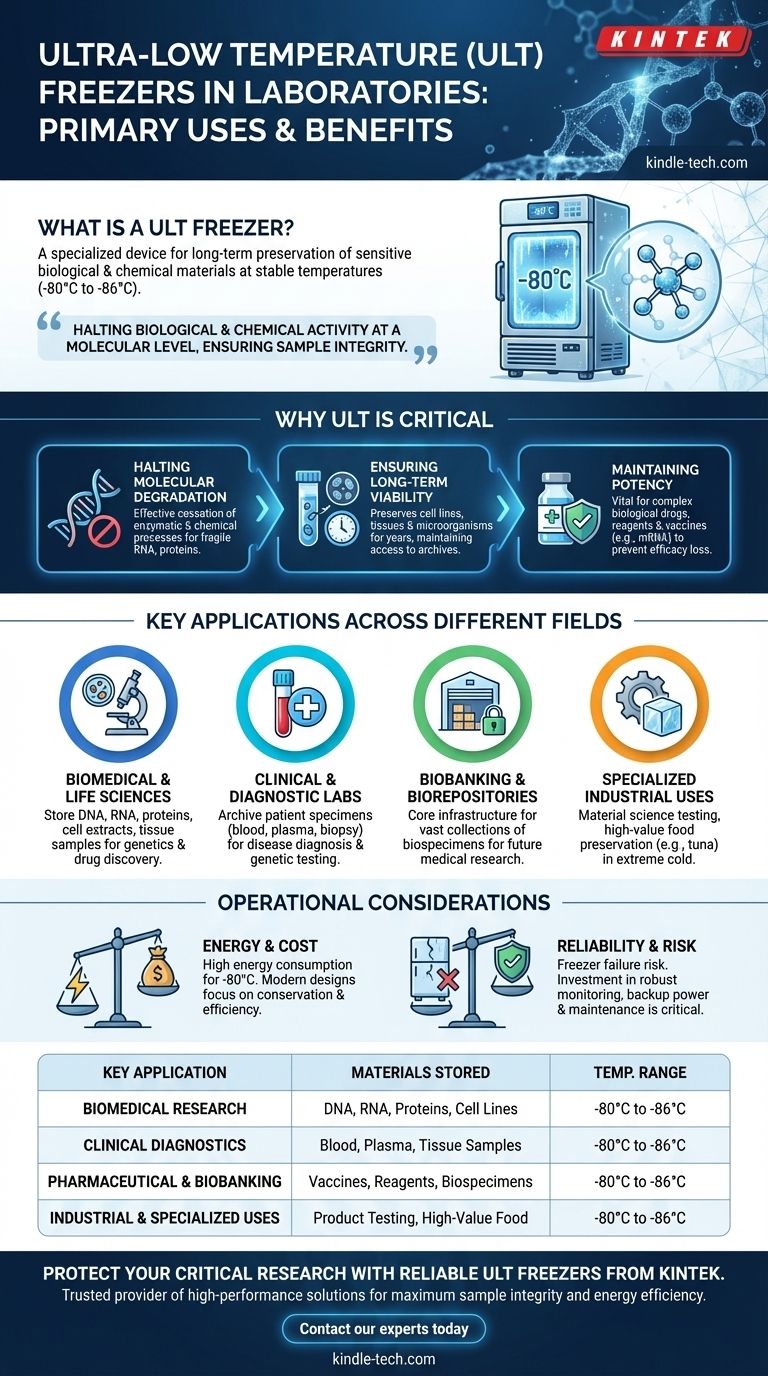At its core, an Ultra-Low Temperature (ULT) freezer is a specialized device used for the long-term preservation of sensitive biological and chemical materials. Laboratories across biomedical research, clinical diagnostics, and pharmaceuticals rely on these units to store everything from DNA, RNA, and proteins to critical vaccines, cell lines, and tissue samples at stable temperatures, typically between -80°C and -86°C.
The fundamental purpose of a ULT freezer is not just to keep samples cold, but to effectively halt biological and chemical activity at a molecular level. This cryopreservation stops the degradation that would otherwise destroy a sample's integrity, ensuring its viability for future analysis, research, or therapeutic use.

Why Ultra-Low Temperatures Are Critical
The difference between standard freezing and ultra-low temperatures is the difference between pausing and stopping biological time. The extreme cold is essential for maintaining the value and usability of sensitive materials over long periods.
Halting Molecular Degradation
At temperatures around -80°C, the enzymatic and chemical processes that break down biological molecules effectively cease. This is particularly crucial for fragile molecules like RNA and proteins, which can degrade rapidly even at standard freezer temperatures.
By arresting this molecular activity, ULT freezers ensure that a sample's genetic or cellular state remains unchanged from the moment it was frozen.
Ensuring Long-Term Viability
Many research projects, especially longitudinal studies and biobanking, require samples to be stored for years or even decades. ULT freezers provide the stable environment necessary to preserve the viability of cell lines, tissues, and microorganisms over these extended periods.
This capability allows researchers to access a consistent and reliable archive of materials for ongoing and future studies.
Maintaining Chemical and Pharmaceutical Potency
ULT storage is also vital in pharmaceutical development and manufacturing. Complex biological drugs, reagents, and vaccines, such as the mRNA COVID-19 vaccines, require these frigid temperatures to prevent their active components from breaking down and losing efficacy.
Key Applications Across Different Fields
While the principle is universal, the specific application of ULT freezers varies depending on the laboratory's focus. Each field relies on them to safeguard its most valuable assets.
Biomedical and Life Science Research
In research universities, medical centers, and biotech companies, ULT freezers are the foundation of modern biological investigation. They are used to store DNA, RNA, proteins, cell extracts, and tissue samples for use in genetics, molecular biology, and drug discovery.
Clinical and Diagnostic Labs
Clinical laboratories and hospitals use ULT freezers to archive patient specimens like blood, plasma, serum, and biopsy tissues. The integrity of these samples is paramount for accurate disease diagnosis, genetic testing, and forensic analysis.
Biobanking and Biorepositories
Biobanks are libraries of biological samples, and ULT freezers are their core infrastructure. They store vast collections of biospecimens from clinical trials and population studies, creating invaluable resources for future medical research.
Specialized Industrial Uses
Beyond life sciences, ULT technology is used for material science and industrial quality control. Manufacturers may use them for testing product reliability under extreme cold conditions, simulating environments like the Arctic.
They are also used in high-value food preservation, particularly in the tuna fishing industry, to halt degradation and maintain quality during transport.
Understanding the Operational Considerations
While essential, ULT freezers are powerful, specialized pieces of equipment with significant operational demands that impact laboratory workflow and budgets.
Energy Consumption and Cost
Maintaining temperatures of -80°C is an energy-intensive process. The operational cost of a ULT freezer is a significant consideration for any lab, which is why modern designs increasingly focus on energy conservation and efficiency.
The Critical Need for Reliability
The single greatest risk associated with ULT storage is freezer failure. A mechanical breakdown can result in the catastrophic and irreplaceable loss of years of research, unique clinical samples, or valuable pharmaceuticals.
Because of this, laboratories invest heavily in robust monitoring systems, backup power supplies, and regular maintenance schedules to ensure uninterrupted operation.
Making the Right Choice for Your Goal
The decision to use a ULT freezer is driven by the intrinsic value and stability of the materials you need to preserve.
- If your primary focus is the long-term archival of irreplaceable samples (DNA, cell lines, or clinical trial specimens): A high-reliability ULT freezer is the only option to prevent molecular degradation over many years.
- If your primary focus is ensuring the potency of sensitive biologicals (vaccines, enzymes, or complex drugs): ULT storage is often required to meet strict regulatory and manufacturing standards for stability.
- If your primary focus is preserving routine diagnostic samples for a few months: A standard -40°C freezer may be sufficient, but a -80°C freezer provides the highest margin of safety against sample degradation.
Ultimately, these freezers serve as the silent guardians of modern scientific and medical progress.
Summary Table:
| Key Application | Primary Materials Stored | Temperature Range |
|---|---|---|
| Biomedical Research | DNA, RNA, Proteins, Cell Lines | -80°C to -86°C |
| Clinical Diagnostics | Blood, Plasma, Tissue Samples | -80°C to -86°C |
| Pharmaceutical & Biobanking | Vaccines, Reagents, Biospecimens | -80°C to -86°C |
| Industrial & Specialized Uses | Product Testing, High-Value Food | -80°C to -86°C |
Protect your critical research and diagnostic samples with reliable ULT freezers from KINTEK.
As a trusted provider of laboratory equipment, KINTEK specializes in high-performance Ultra-Low Temperature freezers designed for maximum sample integrity and energy efficiency. Whether you're in biomedical research, clinical diagnostics, or pharmaceutical development, our solutions ensure your sensitive materials—from cell lines and vaccines to DNA samples—are preserved at optimal conditions.
Contact our experts today to find the perfect ULT freezer for your lab's specific needs and safeguard your most valuable assets.
Visual Guide

Related Products
- 158L Precision Vertical Ultra Low Freezer for Laboratory Applications
- 208L Advanced Precision Laboratory Ultra Low Temperature Freezer for Cold Storage
- 308L Precision Ultra Low Temperature Freezer for Laboratory Applications
- 708L Ultra Low Temperature Freezer High Performance Laboratory Freezer
- 938L Vertical Ultra Low Temperature Freezer for Advanced Laboratory Storage
People Also Ask
- How do Ultra-Low Temperature freezers ensure the integrity of microbiological samples? Maintain Stability for Critical Research
- What temperature range do Ultra-Low Temperature freezers maintain? The -80°C Standard for Sample Integrity
- What are ultra-low temperature freezers designed for? Preserving Your Most Valuable Biological Samples
- What makes Ultra-Low Temperature freezers energy efficient? Key Design & Operational Strategies
- Where are ultra low temperature freezers commonly used? Essential for Labs, Hospitals, and Biotech



















